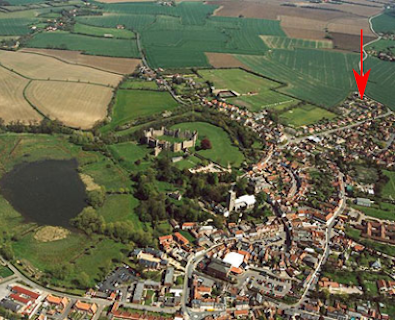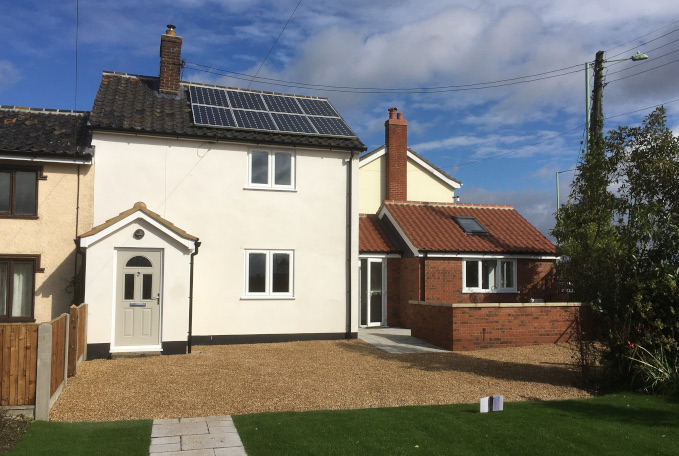 Deeds and records
Deeds and records




"In Liquidation, The Mill Inn, Framlingham, to sell by auction, as interacted by the Trustees of the Estate of M D R DEEKS; also a post wind-mill fitted with iron shaft patent sails, self winding gear & brick roundhouse."
Ipswich Journal, January 4th 1879**
Landlords
1874: "Daniel Read Deeks ((beer house - pub not named) (& corn miller) (Saxmundham rd))"1879: "M D R DEEKS (estate) ((In Liquidation, The Mill Inn, Framlingham - 04 Jan**))"
(**historic newspaper information from Bob Mitchell)
The CAMRA page (wrongly) concludes that:
"The Mill is shown at this location on the 1883 OS map. By the 1888 sheet it's gone and appears to have been demolished, so must have closed between those dates."
 This seems to imply that the author of the CAMRA page (wrongly) thought that the label
'Mill Inn' on the 1883 map pointed to its right, not its left.
This seems to imply that the author of the CAMRA page (wrongly) thought that the label
'Mill Inn' on the 1883 map pointed to its right, not its left. Deeds and records
Deeds and recordsAn 1880
conveyance from Charlotte Garrett to EWC Jeaffreson contains a
plan of the Mill Inn, and the Mill behind, plus outbuildings.
In the writing, it says there's a cottage in the plot where it says
"J Smith" (i.e. where Fuller's Cottages were before they were
demolished for 49). The sale includes "...the stones and weights
ropes sails tackle going gear machinery and appurtenances to the
said Windmill..."
The conveyance says that Mrs Garrett had repossessed the property,
because the previous owner, Henry Whatling, had not honoured his
agreement to repay the £400 mortgage plus £62/14/10d interest that
he had borrowed from her to buy the plot (it actually started out as
£300, then she lent him another £100 later). In 1879 she had tried
to sell the property at auction (see below) but no bid was adequate.
Then Jeaffreson bought it a year later for £450. His address is
given as Viktoriastrasse 8, Saarbrücken 3, Germany.
 The auction
particulars are really informative. It is described as a
liquidation sale and it says the Mill Inn had 5 chambers, so it
would have taken up the whole of Mill House (47) and 45 Sax Rd
(previously I had incorrectly guessed that the Inn was just the
front part where the tap room is). Presumably the water supply it
mentions was the well that is now under 49.
The auction
particulars are really informative. It is described as a
liquidation sale and it says the Mill Inn had 5 chambers, so it
would have taken up the whole of Mill House (47) and 45 Sax Rd
(previously I had incorrectly guessed that the Inn was just the
front part where the tap room is). Presumably the water supply it
mentions was the well that is now under 49. Arthur
died 10 years later (14 May 1922) leaving his widow Sarah (my great great grandmother) in Mill
House. I've found her tenancy
agreement with Arthur's executors as landlords dated the next
year, which is allowing the existing tenant to stay in the front
part (roughly 45) while Sarah continues to live in the back portion
(Mill House) for her lifetime. The tenant (a retired PC) also used
the meadow behind.
Arthur
died 10 years later (14 May 1922) leaving his widow Sarah (my great great grandmother) in Mill
House. I've found her tenancy
agreement with Arthur's executors as landlords dated the next
year, which is allowing the existing tenant to stay in the front
part (roughly 45) while Sarah continues to live in the back portion
(Mill House) for her lifetime. The tenant (a retired PC) also used
the meadow behind. Sarah Larter (photo left, taken outside Mill House) died 29 Jul 1939, and Gloria Lane, who lived in Home Farm
at that time told us that Sarah was a live-in housekeeper
for someone, but Isaac Larter gave her a room in Home Farm for her things.
So I assume, some time before her death, she moved out of Mill House
and became someone else's housekeeper, presumably both for income
and companionship.
Sarah Larter (photo left, taken outside Mill House) died 29 Jul 1939, and Gloria Lane, who lived in Home Farm
at that time told us that Sarah was a live-in housekeeper
for someone, but Isaac Larter gave her a room in Home Farm for her things.
So I assume, some time before her death, she moved out of Mill House
and became someone else's housekeeper, presumably both for income
and companionship.


